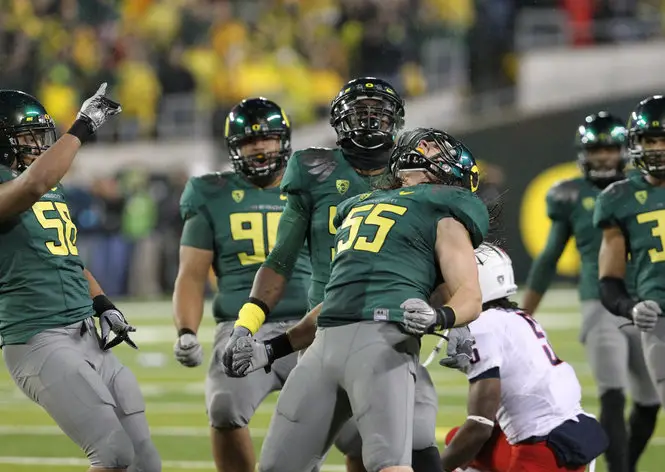
This year’s Oregon Ducks may or may not field a top-notch defensive squad. As I wrote last week, the makings are all there, but success can only be proven on the football field through a season’s worth of games.
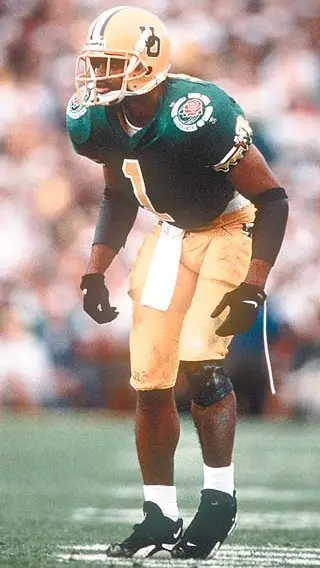
Alex Molden, one of the few ‘stars’ of the 1994 Oregon defense, went on to a long pro career.
If they do, though, the 2012-13 Oregon defenders undoubtedly will be compared to two great defenses of recent Duck lore — the famed “Gang Green” defense from the 1994-95 Rose Bowl team, and the group from 2010-11 that played in the BCS National Championship Game against Auburn.
I mentioned both of those defenses last week as well — mostly in passing. But that got me to thinking; and curious about which of those squads was a better stopper, I spent time digging up records and other information to see how they stack up.
Pretty evenly, as it turns out.
It’s true that it’s risky to compare defensive squads from the same program, particularly ones some 16 years apart. As much as college football stays the same, the more it changes, and the style of play is much more points-friendly today than it was in the mid-1990s. Consider, too, that Oregon’s frenetic offense under Chip Kelly leaves the defense on the field for most of the game now, skewing statistical comparisons with other defenses. Also, given the ‘Oregon brand’ today, the Ducks recruit better athletes under Kelly than they did under Rich Brooks.
I was a witness to virtually every game both defenses played — either in person or on the screen — and even I have a hard time discerning which squad ranks higher. I might give 1994-95 a slight nod for its unbending consistency, and 2010-11 a slight nod for its depth and speed.
As can be seen in the graph on the right, the 1994-95 squad was a little better in rushing defense (rush yardage per play); 2010-11 a little better in passing defense (pass yardage per play and catch). Each gave up about the same number of points on the season; each thrived on creating turnovers.
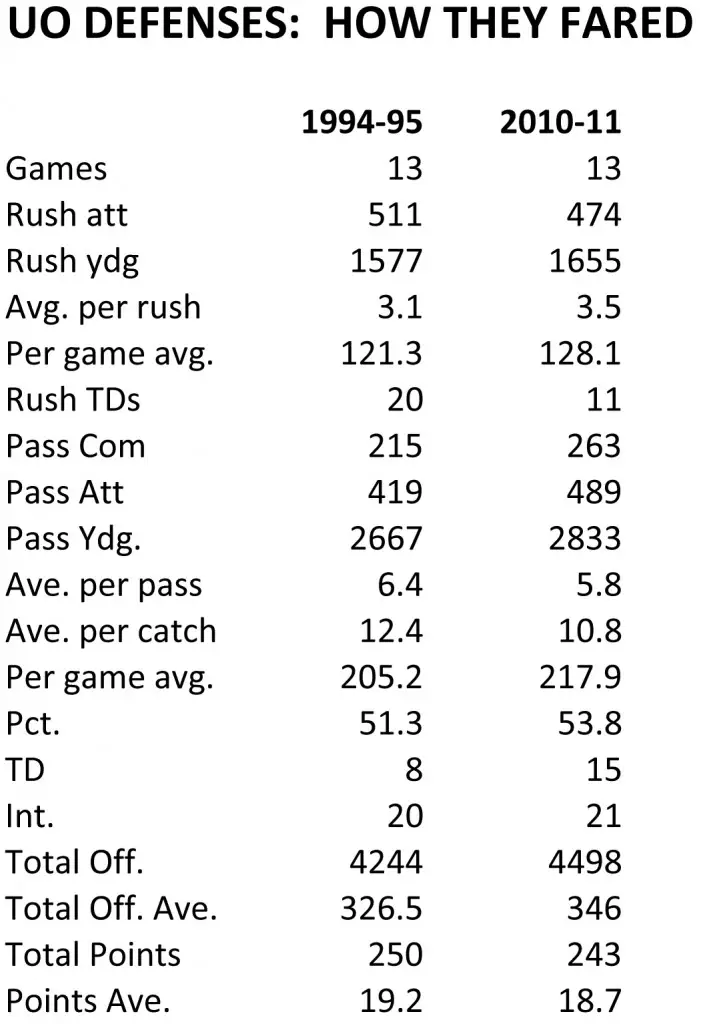
Which brings us to the intangibles, such as how these two defenses performed when it counted most.
The 2010-11 defense was predicated on speed, aggressiveness and take-aways. The line executed well, allowing Oregon’s superb linebackers and ball-seeking secondary to take care of business and attack with regular blitzes. The Ducks were third in the nation in creating turnovers and fifth in red-zone defense.
Like all good defenses, it got great play from several players. While linebacker Casey Matthews (79 tackles, including nine for a loss, three interceptions and three fumble recoveries) and cornerback Cliff Harris (six interceptions, 17 passes broken up) received plenty of accolades, they weren’t alone. Spencer Paysinger, John Boyett, Kenny Rowe, Brandon Bair, Talmadge Jackson, Zac Clark, Terrell Turner, Eddie Pleasant, Boseko Lokombo, among others, filled big roles and were play-makers in their own right.
The team that fell to Auburn 22-19 in the national title game has mostly been celebrated for its offensive fireworks. Oregon led the nation in scoring 47.0 points per game and featured stars like LaMichael James, Darron Thomas, Kenjon Barner, Jeff Maehl, Drew Davis, David Paulson and Josh Huff.
But the defense was equally good, particularly when it mattered most. Over the course of the season, it surrendered just 6.8 points a game in the second half. Eight of the 13 teams it faced didn’t score a point in the fourth quarter. And that for a squad that was frequently on the field due to the team’s quick-strike offense.
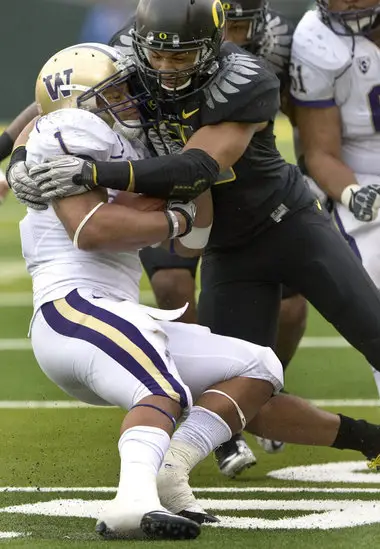
Spencer Paysinger, a linebacker on the 2010-11 team, now plays for the New York Giants.
The 2010-11 defense’s big moment may have been at California. Ranked No. 1 in the nation, the Ducks struggled mightily on offense in the darkness of Berkeley. If it hadn’t been for the defense — which held the Bears to just a touchdown and 193 total yards — Oregon likely would have fallen instead of pulling out a 15-13 win.
And in the waning minutes of the BCS Championship Game, with the Ducks trailing 19-11, Matthews stripped the ball from Heisman Trophy winner Cam Newton, leading to a late Oregon score and a 19-19 tie. Auburn’s game-winning field goal as time expired were just the fourth, fifth and sixth points the Tigers scored after intermission.
“We’re like a great white shark in the ocean just swimming on the surface,” the incomparable Cliff Harris said in the days leading up to the title game. “Everything that’s in front of us, we eat it up.”
In his own way, Harris was right.
The 1994-95 defense was not so much flash as it was unyielding and smash-mouth tough. It ranked 12th in the country in rushing defense and recorded 30 sacks and 20 interceptions. Its best athletes were arguably in the secondary: Alex Molden (All Pac-10), Kenny Wheaton (four interceptions), Chad Cota (All Pac-10), Herman O’Berry (All Pac-10) and Jeff Sherman (109 tackles); but its linebackers weren’t far behind. Reggie Jordan, who was paired with Derrick Barnes on the outside, led the team in sacks and tackles for loss. Inside backers Rich Ruhl (103) and Jeremy Asher (91) were among the leading tacklers. Upfront there was stout nose tackle Sallila Malepeai.
Unlike the 2010-11 team, the 1994-95 squad was coming off a 5-6 year and was picked to finish no higher than seventh in the Pac-10. It also overcame a 1-2 start that had some calling for Rich Brooks’ head.
In eight league games, Oregon gave up just 13.5 points per game, including holding USC to seven in Los Angeles.
Wheaton’s 97-yard interception return against Washington — arguably the greatest moment in Oregon football history — was the signature play. But the defense’s performance at home a week later against No. 11 Arizona was undoubtedly its best performance all season and kept the Ducks on the path to their first Rose Bowl in 37 years.
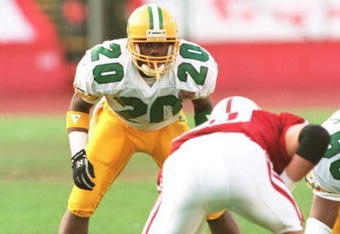
Kenny Wheaton
The Ducks played well defensively in the first half against Arizona, but still trailed 9-0 at intermission. From then on, though, it was all Oregon. Aided by the noisy Autzen crowd, Gang Green held the Wildcats scoreless in the second half, never allowing them to cross midfield, as the Ducks prevailed 10-9.
“We were just a bunch of average blue-collar guys,” Mark Schmidt, a sophomore defensive lineman on the 1994-95 team, told FishDuck.com recently. “We had just a few top-caliber athletes, but how we were successful on the Gang Green was we played together as a team and did whatever it took to get the job done.”
In 2005, the entire team was inducted into the UO Hall of Fame.
Interestingly, one of the few common denominators between the 1994-95 and 2010-11 teams is that both had the same defensive coordinator, one Nick Aliotti. I don’t know if Aliotti has ever publicly commented how his two squads stack up. I did some research and couldn’t find anything. I wish he would. It would be interesting to see what he has to say.
In the meantime, with no clear-cut winner, we’re left to compare, contrast, consider, ponder, wonder.
And — if you’re a Duck fan — hope the 2012-13 Oregon defense enters this same discussion some day.
What would Nick say then?
Related Articles:
These are articles where the writer left and for some reason did not want his/her name on it any longer or went sideways of our rules–so we assigned it to “staff.” We are grateful to all the writers who contributed to the site through these articles.
